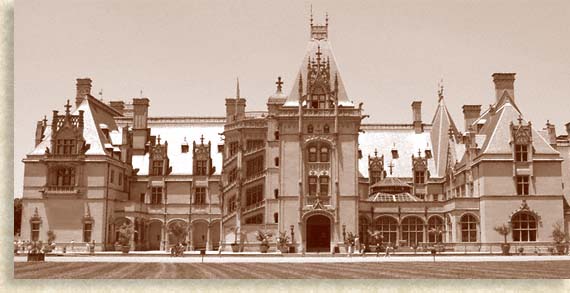
Biltmore was officially opened on Christmas Eve 1895 with a holiday feast and a coaching party. It was the first of many gala affairs at the Estate with luminaries like novelist Edith Wharton and Henry James as honored guests. Here in society’s new playground was an array of activities from tennis, croquet and archery, hunting, riding, and picnicking with concerts, dancing and parlor games.
This is what George so long for, a home for entertaining and displaying his treasured art, a reflection of his vision. George was a man who enjoyed sharing his advantages with others.
Looking around at his dream, George saw there was one very important element missing, someone to be his significant other, a loving wife. Mr. George Washington Vanderbilt and American socialite Edith Stuyvesant Dresser (1873-1958) were married in Paris, June 1898, honeymooning in Europe. Two years later they announced the birth of their only child, Cornelia (1900-1976) a life long resident at Biltmore.
George had everything he ever dreamt of, a mansion to house his collection, a productive self-supporting enterprise, more land than anyone could conceive but most importantly, a family all his own with a beautiful daughter to carry on the Vanderbilt legacy.
The Vanderbilt's were dedicated to helping others. They purchased the nearby town of Best which housed most of the estate’s employees and renamed it Biltmore Village in 1889. The quaint town grew under the Vanderbilt’s guidance between 1896 and 1902, with a church, school, hospital and shops. Estate employees lived in cottages that were equipped with central heating and plumbing, not the norm for the late 19th Century.
The Vanderbilt's maintained a rather large staff at the Biltmore, providing good wages and accommodations. At Christmas time the Vanderbilt's would decorate an enormous tree in the Great Hall and have a special celebration with gifts for their staff and their children.
In 1889 the Vanderbilt's took considerable pleasure in founding the Biltmore Forest School, the first institute for scientific forestry in America. George and Edith also founded Biltmore Estate Industries in 1901, for the purpose of creating an apprenticeship program to teach traditional crafts such as weaving and woodworking. Students enjoyed creating many things, including reproductions of furnishings within the mansion and were encouraged to sell their works for income.
The success of the apprenticeship program encouraged Edith Vanderbilt to start the School for Domestic Science, where young women were instructed in housekeeping skills such as cooking and cleaning enabling the students an advantage in obtaining job opportunities.
The Vanderbilt’s owned several residences, including his parent’s original Fifth Avenue mansion. Yet it was apparent that Biltmore was their favorite. Their involvement in the operations of the estate was a personal joy.
Life was great, and remained good until an unfortunate day in March 1914 when George was rushed to a hospital in Washington D.C. where he received an emergency appendectomy to no avail. George Washington Vanderbilt passed on and was buried in the family mausoleum, on Staten Island, New York.
Devastated by her loss, yet championed by duty, Mrs. Vanderbilt returned to Biltmore to carry on her responsibilities at the estate and within the community. She advocated many worthwhile causes; literacy programs, she helped build a new hospital as well as served as woman president of the state agricultural society.
In 1915 Edith Vanderbilt sold nearly 87,000 acres of land to the federal government in respect for George’s wishes to preserve his forest land for the public.
Selling Biltmore Estate Industries in 1917 and Biltmore Village in 1921 helped Mrs. Vanderbilt consolidate her responsibilities to Biltmore Estate. In 1925 Edith married Senator Peter G. Gerry, the couple maintained several residences, Providence, Rhode Island and Asheville.
George and Edith’s only child, Cornelia (1900-1976) was married at the All Soul’s Church in Biltmore Village in 1924 to the honorable John Francis Amherst Cecil (1890-1954). Cecil was a descendant of Lord Burghley, the Lord High Treasurer to Queen Elizabeth I.
Cornelia and John Cecil continued to live at the Biltmore giving birth to two sons, George Henry Vanderbilt Cecil (1925) and William Amherst Vanderbilt Cecil (1928).
Back to the Biltmore Estate Main Page
![]()
Sign
up for the Blue Ridge Highlander Newsletter, Messages from the Mountains
to find out first about our new feature stories, road trips and special offers
Your e-mail addresses will not be sold or given away to anyone.
Privacy
Policy
Interested in your business being on the Highlander, click here...
Let our visitors tell you about the Highlander...
Click the feathers to go to the Highlander site
map...


